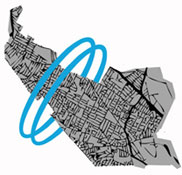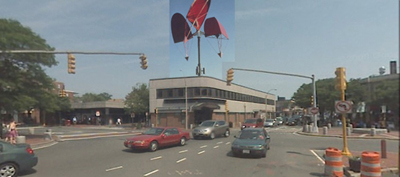
| 2010s | - | 2020s | - | 2030s | - | 2040s | - | 2050s | - | 2060s | - | 2070s | - | 2080s | - | 2090s | - | 2100 | |
| 2010 | - | 2011 | - | 2012 | - | 2013 | - | 2014 | - | 2015 | - | 2016 | - | 2017 | - | 2018 | - | 2019 |
|
Davis Square,
2014: Somerville installs more of the rotating red sculptures
currently on display at the Porter Square T stop. They are cleverly-disguised
wind turbines. Click on a decade or year above to read about the future.
|
Introduction to the 2010s Besides the destruction of the Universe in late 2012, the 2010s see a great many changes in Somerville. Many families move out of town, due to the poor quality of city's schools. The vacuum this creates is filled with more and more young people, who bring with them a different set of interests. Suddenly, there is a major push towards community sharing. Mobile libraries circulate through town; these libraries also lend tools, art supplies, and other useful items. A community print shop also opens up, as does an artisan craft and food mart that allows residents to sell the food they make at home. This same shift in demographics also causes the city to sell the old Powder House School to developers in 2010, and to provide even less funding for schools. This, in turn, causes more families to move out. By the end of the decade, East Somerville is the cultural focus of this new Somerville, a dog is its mayor, and Tufts University is its overlord. The city's residents take a number of steps to protect the environment. Gyms are now powered by the exercise that people do in them. Wind turbines are placed around town, on hills and on top of buildings; some are disguised as sculptures. Microgenerators appear on doors, harnessing power from their openings and closings. Property owners use all of these devices to sell electricity back to the system. To reward these property owners, the city decreases property tax; in turn, owners stop raising rent. More and more members of the community become environmentally conscious. Many businesses stop offering Styrofoam packages and plastic bags; widespread community composting and recycling help to minimize trash and litter. Bicycles become very popular--so much so that the city creates special bike lanes on every street, extends the bike path to Boston, and converts hundreds of parking spaces for cars into parking spaces for bikes. As a result, more and more people get rid of their cars, and convert their driveways to gardens. Some see this as a backlash against the surge in car traffic that began the decade. The Green Line extends to Union Square, and to Medford. This takes place twice: in 2014, and then again the next year. The McGrath Highway is lowered, most likely as a result of the extension. Somerville also gets its own Orange Line stop in 2013, as part of the development of Assembly Square; however, this is a temporary gain, as Assembly Square is flooded the same year by rising sea waters. The MBTA's new Somerville service proves unreliable. Fed up and frustrated, the city establishes its own public transit system. This system consists of hybrid vans which cost $1 per ride, and come every five minutes. Rounder Records breaks away from its parent corporation, and returns to Somerville in 2017, where it becomes a major force in the record industry. Rounder workers create an algorithm that identifies illegal file-sharing on the web. Their stock soars overnight, and millions of new dollars are pumped into Somerville's economy. Nationally, the US government splits its focus between space travel and the environment. NASA continues exploring space, sending missions to Mars and Venus. Solar power competes with fossil fuels in cost. A ban is introduced on incandescent light bulbs. The decade also sees the qualifying age for Medicare reduced to 55; the first woman president of the United States; and wars between the US and Iran, and between the US and North Korea. While these
changes are taking place, the country's economy begins to spiral
downwards. Globally, there are drastic changes as well. The US's
economic nosedive causes other national economies to begin to fail.
With over 7 billion people now on the planet, resources become strained.
Water shortages lead to riots worldwide. A large chunk of the population
becomes vegetarian, by choice or by necessity.
|
